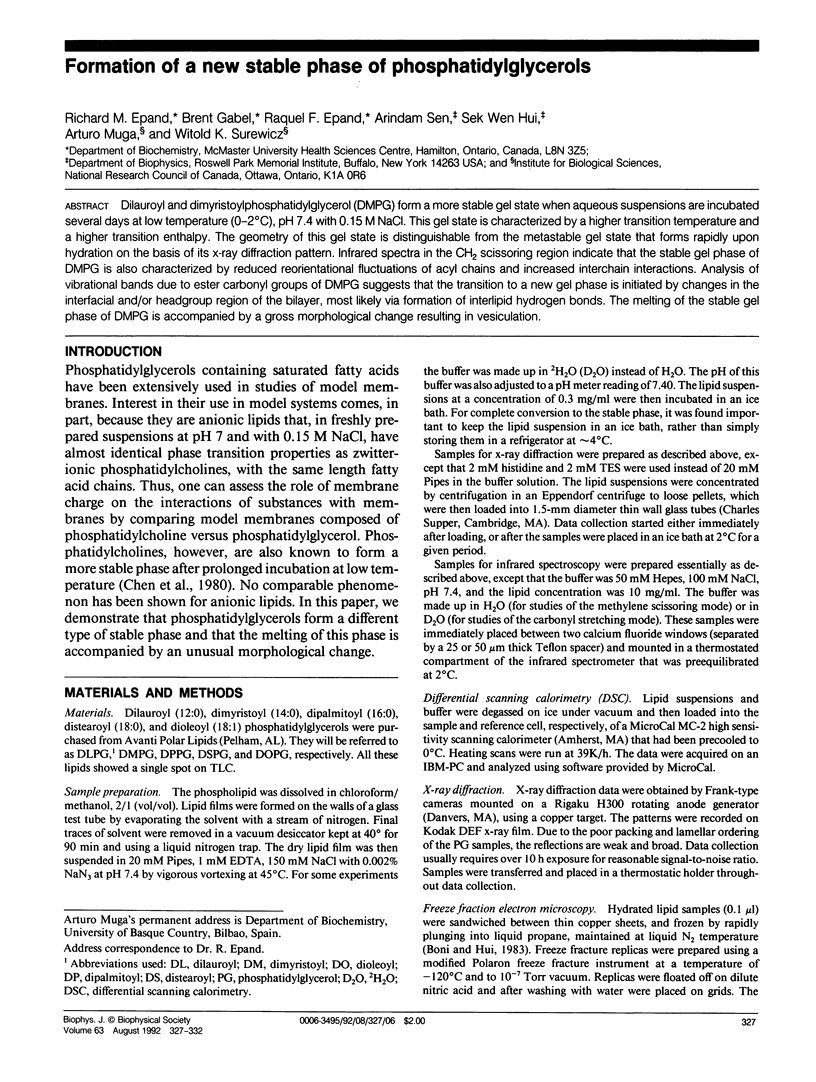Abstract
Dilauroyl and dimyristoylphosphatidylglycerol (DMPG) form a more stable gel state when aqueous suspensions are incubated several days at low temperature (0-2 degrees C), pH 7.4 with 0.15 M NaCl. This gel state is characterized by a higher transition temperature and a higher transition enthalpy. The geometry of this gel state is distinguishable from the metastable gel state that forms rapidly upon hydration on the basis of its x-ray diffraction pattern. Infrared spectra in the CH2 scissoring region indicate that the stable gel phase of DMPG is also characterized by reduced reorientational fluctuations of acyl chains and increased interchain interactions. Analysis of vibrational bands due to ester carbonyl groups of DMPG suggests that the transition to a new gel phase is initiated by changes in the interfacial and/or headgroup region of the bilayer, most likely via formation of interlipid hydrogen bonds. The melting of the stable gel phase of DMPG is accompanied by a gross morphological change resulting in vesiculation.
Full text
PDF





Images in this article
Selected References
These references are in PubMed. This may not be the complete list of references from this article.
- Blume A., Hübner W., Messner G. Fourier transform infrared spectroscopy of 13C = O-labeled phospholipids hydrogen bonding to carbonyl groups. Biochemistry. 1988 Oct 18;27(21):8239–8249. doi: 10.1021/bi00421a038. [DOI] [PubMed] [Google Scholar]
- Boni L. T., Hui S. W. Polymorphic phase behaviour of dilinoleoylphosphatidylethanolamine and palmitoyloleoylphosphatidylcholine mixtures. Structural changes between hexagonal, cubic and bilayer phases. Biochim Biophys Acta. 1983 Jun 10;731(2):177–185. doi: 10.1016/0005-2736(83)90007-x. [DOI] [PubMed] [Google Scholar]
- Casal H. L., Mantsch H. H., Hauser H. Infrared studies of fully hydrated saturated phosphatidylserine bilayers. Effect of Li+ and Ca2+. Biochemistry. 1987 Jul 14;26(14):4408–4416. doi: 10.1021/bi00388a033. [DOI] [PubMed] [Google Scholar]
- Casal H. L., Mantsch H. H. Polymorphic phase behaviour of phospholipid membranes studied by infrared spectroscopy. Biochim Biophys Acta. 1984 Dec 4;779(4):381–401. doi: 10.1016/0304-4157(84)90017-0. [DOI] [PubMed] [Google Scholar]
- Chen S. C., Sturtevant J. M., Gaffney B. J. Scanning calorimetric evidence for a third phase transition in phosphatidylcholine bilayers. Proc Natl Acad Sci U S A. 1980 Sep;77(9):5060–5063. doi: 10.1073/pnas.77.9.5060. [DOI] [PMC free article] [PubMed] [Google Scholar]
- Epand R. M., Hui S. W. Effect of electrostatic repulsion on the morphology and thermotropic transitions of anionic phospholipids. FEBS Lett. 1986 Dec 15;209(2):257–260. doi: 10.1016/0014-5793(86)81123-1. [DOI] [PubMed] [Google Scholar]
- Hui S. W., Stewart T. P., Yeagle P. L. Temperature-dependent morphological and phase behavior of sphingomyelin. Biochim Biophys Acta. 1980 Sep 18;601(2):271–281. doi: 10.1016/0005-2736(80)90532-5. [DOI] [PubMed] [Google Scholar]
- Wong P. T., Siminovitch D. J., Mantsch H. H. Structure and properties of model membranes: new knowledge from high-pressure vibrational spectroscopy. Biochim Biophys Acta. 1988 Feb 24;947(1):139–171. doi: 10.1016/0304-4157(88)90023-8. [DOI] [PubMed] [Google Scholar]




